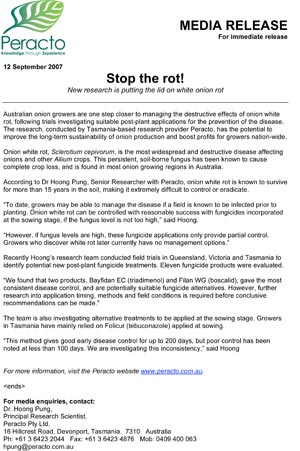|
|
Australian onion growers are one step closer to managing the destructive effects of onion white rot, following trials investigating suitable post-plant applications for the prevention of the disease. The research, conducted by Tasmania-based research provider Peracto, has the potential to improve the long-term sustainability of onion production and boost profits for growers nation-wide. Onion white rot, Sclerotium cepivorum, is the most widespread and destructive disease affecting onions and other Allium crops. This persistent, soil-borne fungus has been known to cause complete crop loss, and is found in most onion growing regions in Australia. According to Dr Hoong Pung, Senior Researcher with Peracto, onion white rot is known to survive for more than 15 years in the soil, making it extremely difficult to control or eradicate. To date, growers may be able to manage the disease if a field is known to be infected prior to planting. Onion white rot can be controlled with reasonable success with fungicides incorporated at the sowing stage, if the fungus level is not too high, said Hoong. However, if fungus levels are high, these fungicide applications only provide partial control. Growers who discover white rot later currently have no management options.
Findings : Recently Hoongs research team conducted field trials in Queensland, Victoria and Tasmania to identify potential new post-plant fungicide treatments. Eleven fungicide products were evaluated. We found that two products, Bayfidan EC (triadimenol) and Filan WG (boscalid), gave the most consistent disease control, and are potentially suitable fungicide alternatives. However, further research into application timing, methods and field conditions is required before conclusive recommendations can be made. The team is also investigating alternative treatments to be applied at the sowing stage. Growers in Tasmania have mainly relied on Folicur (tebuconazole) applied at sowing. This method gives good early disease control for up to 200 days, but poor control has been noted at less than 100 days. We are investigating this inconsistency, said Hoong Acknowledgements : These research studies were conducted as project VN05007 and project VN05010, which are facilitated by the Australian Onion Industry Association and Horticulture Australia Limited. These projects are funded by Australian onion growers and voluntary contributions from Bayer CropScience Pty Ltd, Nufarm Australia Limited, Syngenta Crop Protection Pty Ltd and DuPont (Australia) Pty Ltd, with matching funds from the Australian government through Horticulture Australia Ltd. |
||||||
|

